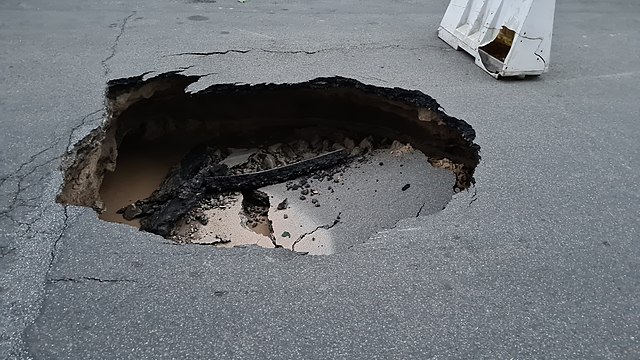Extreme NYC weather prompts call for infrastructure improvements
September 3, 2022
A sinkhole opened up in the Bronx and swallowed a van on July 19 during heavy rainfall. In a statement to CBS2, the New York City Department of Environmental Protection speculated that the sinkhole started forming during the storm, with DEP Commissioner Rohit Aggarwala citing cracks in the decades-old system for exacerbating the problems. Residents in Morris Park said that the sinkhole was the second in nearly a year.
Repairs to the area were still ongoing over a month later. In a report by CBS2, parts of Radcliff Avenue in Morris Park were closed off to conduct repairs on the sinkhole that “formed after heavy rain.” Councilperson Selvena Brooks-Powers stated that she was working to “identify grant opportunities to get federal dollars into New York City” in order “to make these infrastructure repairs as needed.”
Sinkhole occurrences have also been seen in other parts of the city. During the 2022 fiscal year that ended in June, the DEP identified more than 3921 sinkholes, a 38% increase from 2021, according to the New York Daily News.
The city’s sewers were built back in 1916 and are only able to accommodate up to 1.5 inches of rain while the city’s current standard is 1.75 inches. Aggarwala believes that even the current standard may not be enough due to the effects of climate change bringing more powerful storms to New York City’s shores.
On Aug. 16, New York City council members held a hearing to discuss plans for the city’s infrastructure to cope with the new weather at the height of the city’s longest heatwave since 2013.
At the hearing, Aggarwala said that Mayor Eric Adams’ Administration is looking for long-term solutions, including longer term coastal protection projects and zoning amendments for more sustainable building. Though Adams announced that a $50 million sewage and water system expansion in southeast Queens was completed, the fixes are costly and Aggarwala believes that an increase in capital funding alone would not “systematically reduce the likelihood of sinkholes.”
The committee released a new report after the hearing that touched on the state of the city’s roadways. In the fiscal year of 2021, 26% of roadways were reported to be in poor condition. The report concluded that “On average, city roads outlive their useful life by 20% before being resurfaced or reconstructed, presenting a source of danger for the period of time between the end of their useful life and resurfacing or reconstruction.”
Aggarwala acknowledged that New York City will be forced to respond in order to prevent the harm that extreme weather inflicts. Citing a city program that provides sandbags and inflatable dams, Aggarwala referred to current measures as “a number of Band-Aids to get us through the period of time it’ll take to get our infrastructure up to where it needs to be.”1,500 people were reported to have signed up for the program out of the city’s nearly 16,000 housing projects.
Many council members emphasized the urgency of recognizing the situation’s effects on low-income and/or minority New Yorkers. New York City Department of Health and Mental Hygiene noted Black New Yorkers are more likely to die from heat stroke than their white counterparts.
Many have deemed the city’s program to be of questionable effectiveness.
In an interview with Curbed, Columbia University professor and former New York City Department of Housing Preservation and Development executive director, Deborah Helaine Morris, argued that the stop-gap measures may make flooding worse. Morris believed the best course of action is to present people “with different housing options that allow them to live in safer locations. And that means more housing and certainly more consistent investment in public flood infrastructure.”
In the hearing, Brooklyn-based Council Member Ari Kagan questioned “Why are we still concentrating on stopgap measures like inflatable dams and sandbags?”
Council Member Mercedes Narcisse concurred, asking why the city administration did not provide all New York City Housing Authority houses with cooling systems.
Given the age of the infrastructure and unequal borough sewer designs, city agencies and lawmakers are worried that the extreme weather could push the systems to the brink.
Until the mid-1970s, borough presidents were charged with sewer system regulations before the standardization of city infrastructure.
Though the DEP is looking to up the sewer capacity from 1.75 inches, they will have to tear down buildings to make way for the larger infrastructure.
“It would be wrong for anyone to think that the sewer system can or should be designed for a 4-inch storm,” Aggarwala added.
He emphasized that heavy construction, planning and public engagement would take time.
“Even if we operated under pandemic-like emergency procedures, it would still take a long time to change our infrastructure,” Aggarwala said.







